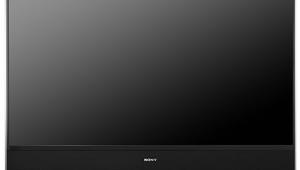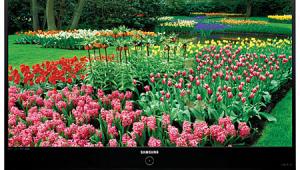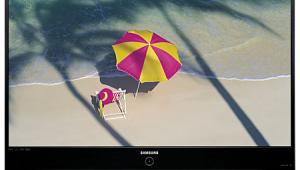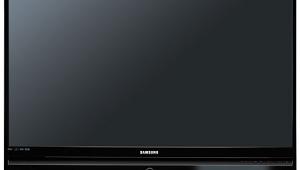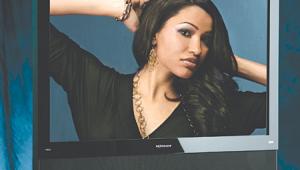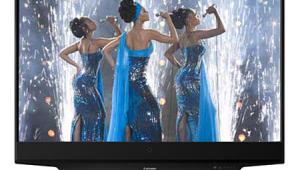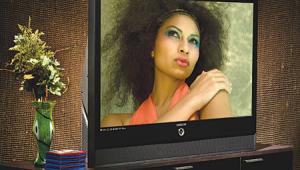Samsung HL-T5687S 1080p DLP Rear Projection HDTV Page 3
At the current state-of-the-art, LEDs as a display light source are less bright than projection lamps, so I suspect that the gain of the Samsung's screen is higher than what's typically used with most lamp-based RPTVs. That isn't certain, and Samsung suggested that it is not the case here. But high gain screens, in general, contribute to hot spotting, as well as the fall off of brightness that occurs with all high gain screens if you sit off center.
Even with its LED light source, the Samsung is very bright—pushing 100 foot-Lamberts in Movie mode. This makes the set slightly uncomfortable to view in subdued room lighting. But the Samsung has no iris adjustment, either fixed or dynamic, that might help compensate for this. The set does have a two-step iris adjustment in the service menu (the standard setting and a single lower output option), but we were not instructed on its use by Samsung. In any case, an iris can do nothing about the set's uneven brightness across the screen.
The high brightness of the set seriously compromises the Samsung's deep blacks. Its black level is one of the poorest we've measured in a recent digital set—of any type. On Dark, low contrast scenes, such as the opening below deck sequence in Master and Commander: The Far Side of the World the Samsung had that grayed, foggy appearance I haven't seen to this degree for some time.
Even most of the flat panel LCDs we've tested recently, including Samsung's own LN-T5265F, have significantly darker blacks. These sets may not be as bright as this DLP at the top end, but they're plenty bright enough for most home viewing.
The Samsung also has some convergence issues, particularly at the top half of the screen where red is misaligned by a pixel or slightly more. This likely originates in the optical path, since there can be no pixel misalignment in a single-chip DLP.
The Samsung will not accept a 480i input over HDMI, so I checked its standard definition video processing (deinterlacing and scaling from 480i to the set's native 1080p) with a component input. Where appropriate and possible, I turned on the Film mode for these tests. (Film mode may be engaged only with a 480i component source.)
The set earned a fair grade on my mix of standard definition video processing tests. It missed a good grade only because of failure on the Jaggies 2 test on the Silicon Optix HQV Benchmark SD test disc, and a fair performance on the waving flag on the same disc. But it picked up 3/2 pulldown quickly, handled both the 2/2 (video) and 3/2 (film) cadence tests well, and sailed through the Coliseum flyover test on Gladiator (Chapter 12) without a glitch.
The Samsung properly deinterlaced 1080i-to-1080p material as tested on the HD HQV Benchmark test disc, but did not recognize and properly process 3/2 pulldown in a 1080i source. Lack of 3/2 recognition also caused flicker and/or moiré on the racetrack test for 3/2 pulldown on the Stacey Spears/Don Munsil HD DVD test disc and on the Blu-ray Disc of MI3 (in the detailing on the brick Vatican wall in Chapter 7 and the staircase at the start of chapter 8). The processor's performance was also just fair on the Jaggies test on the HQV HD disc.
Video processing artifacts on the Samsung, however, were rare on most normal program material.
The Samsung will accept a 1080p/24fps input, but it converts it internally to 1080p/60fps prior to display. And it will not accept a 1080p/24fps input from Samsung's own BD-P1200 Blu-ray player, a trait it shares with the Samsung LN-T5265F flat panel LCD.
It did accept a 1080p/24 input from the Pioneer Elite BDP-HD1 BD player, but its 24fps performance with that player was unsatisfactory. It skipped a frame or two every few minutes, which caused the image to stutter. I sent 1080p/60 to the set for all of my HD disc viewing.
Conclusions
The Samsung does have its strengths, not the least of which are fine color performance and good resolution. It's also relatively inexpensive for a 56-inch set from a major manufacturer.
But when a DLP rear projection set is outperformed in its ability to produce deep, rich blacks by many LCD flat panel displays—including Samsung's own LN-T5265F (which impressed me greatly when I reviewed it recently)—I have to scratch my head. Yes, the LCD set is smaller and, at least at list prices, much more expensive. But it's clearly the better set.
Highs
Excellent detail, particularly on HD material
Fine color
Good price for a set with cutting edge LED light source
No projection lamp to replace
Lows
Poor black level
Noticeable hot spotting on the screen results in brightness and color uniformity issues
Did not perform well with 24fps input
A full calibration is much more complex and time consuming than for most sets



